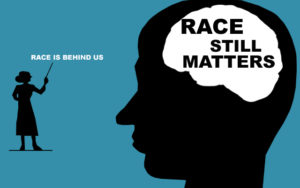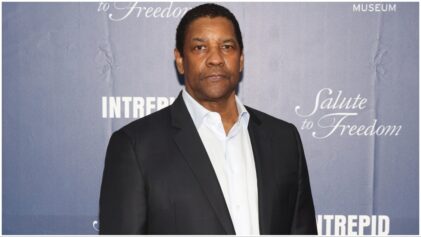
White supremacy is a problem, as it has been for hundreds of years — in a nation where white privilege is palpable, and the indignities and injustices against Black people are self-evident. And yet, we are told racism is a thing of the past and there are no racists, except for a few Klan holdovers from another era wearing white sheets.
Racism is built into the fabric of America, a nation in denial. And it is all based on a system of white privilege that has created and benefited from the badge of slavery. Let us be clear: We are having this discussion because white people decided to kidnap Africans and transport them in floating dungeons. This is where our trauma only began. And of the millions sent across the Middle Passage for a lifetime of forced labor, rape and torture, theft and genocide, half of us never made it, their souls still resting at the bottom of the Atlantic Ocean.
Those who survived suffered in perpetuity and intergenerational basis, as they were not meant for anything but a permanent prisoner status in the slavery police state, an inherited and immutable status. However, even when the physical shackles were removed, the systems of oppression remained. The terrorism against Black folks never abated, the lynchings and mass incarceration never subsided, the clever tools of obstruction and weapons of repression never discarded.
Blatant examples of the current racism are easy to find these days. As Yesha Callahan pointed out in The Root, one case was from a white supremacist football fan who wrote a letter to sports writer Kimberley Martin of Newsday, about how much he hates Carolina Panthers quarterback Cam Newton, and “n*ggers” in general. Apparently he did not realize Martin is a Black woman:
“…Do yourself a favor and stay away from them as much as possible.” #PostRacialAmerica pic.twitter.com/lb9jXDNYri
— Kimberley A. Martin (@KMart_LI) February 20, 2016
A LOT of you have said that I should have included the letter writer’s name. But for me, it’s about “shaming” another person (1)
— Kimberley A. Martin (@KMart_LI) February 20, 2016
It’s a reminder that racism, bigotry + prejudice are still rampant. We’ve made strides as a society, but let’s not act like all is well (2)
— Kimberley A. Martin (@KMart_LI) February 20, 2016
I’ve heard the following quite a bit today: “I can’t believe someone would say such a thing!”
My question is: “Why can’t u believe it?”
— Kimberley A. Martin (@KMart_LI) February 20, 2016
I’ve been called the n-word before, and so have some of my colleagues. …I also deal w/ sexist comments a lot. That shouldn’t surprise ppl.
— Kimberley A. Martin (@KMart_LI) February 20, 2016
On the other hand, there are the microaggressions that Black people, including Black high school and college students, face. UCLA Faculty Diversity & Development defines microaggressions as “everyday verbal, nonverbal, and environmental slights, snubs, or insults, whether intentional or unintentional, that communicate hostile, derogatory, or negative messages to target persons based solely upon their marginalized group membership.”
“Microaggressions are likely an enacted form of implicit bias. They grow out of many different perceptions we have internalized over the process of our socialization,” says Carola Suárez-Orozco, a professor at UCLA’s Graduate School of Education & Information Studies and a psychologist. Suárez-Orozco told Ampersand that microaggressions, or MAs, often are expressed by someone in authority.
“This behavior is learned in the home, through the media, picked up from our peers and others, and it’s at work on many different levels in our society,” she says.
Further, UCLA Professor and Associate Dean for Equity and Diversity Daniel Solorzano believes that MAs are damaging and designed to disempower people of color and those who live on society’s margins, taking a mental, physical and academic toll on minorities.
“They are layered assaults, based on a person of color’s race, gender, class, sexuality, language, immigrations status, phenotype, accent, or surname,” Solorzano says.
In an op-ed in the Los Angeles Times, Jim Grimsley illuminates the problem in a most enlightening manner. He talks about the discussions he holds with people about race, and while Black people are far too aware that little has changed, white people are as blind as ever.
“More than simple anecdotes,” he writes, “these are symptoms of the insanity of white culture and our refusal to understand that racism is part of our makeup — each and every one of us, north, south, east and west — from cradle to grave.” He continues:
We re-segregate our schools using every available strategy and continue to profit from long-standing systems that are biased toward the hiring, advancement and empowerment of white people, all the while decrying the racism we see in others, pointing fingers at this or that extremist. As if by saying, “That one is a racist,” we exonerate ourselves of the charge.
White liberals — and I am one — are adept at using these naming and shaming tactics to avoid looking inward. Comfortable in our beliefs, we ignore the fact that we sit inside an ideology of white superiority that gives us enormous advantages even when we mouth the right opinions, trade memes about the awful racist act that one of us committed, and pat ourselves on the back for our sensitivity.
From the most conspicuous and vocal white supremacist who supports Donald Trump and his campaign to “make America great again,” to the white “liberal” who offends our Black sensibilities yet falls back on the claim that some of their best friends are Black, racism is ingrained. It is ingrained in the institutions that keep Black people back — by policy, custom and practice. This is what happens when racist stereotypes and the n-word become a law. This is why Black people can’t get a job, a mortgage, or an Oscar. And you can chalk it up to the badge of slavery, of which the flip side is the membership card of white privilege. We must deal with it, and white people certainly must deal with it.


